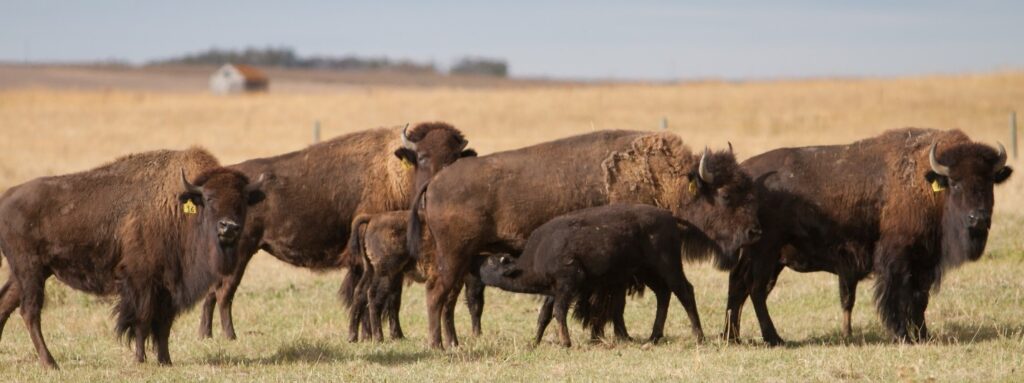Wood bison are big animals with a very small population, mainly concentrated in Canada’s north, where they evolved and live primarily in the boreal forest. This iconic Canadian species, the largest land animal in Canada, has always been important to First Nation and Metis Nation peoples in those territories – culturally, economically, materially and spiritually – but disease and declining numbers across its range risks further wood bison population decline if nothing is done to protect them. Without bison on the landscape, ecosystem and cultural connections are broken.
Ranging in small, isolated wild herds across Yukon and the Northwest Territories, Alberta, Manitoba and British Columbia, wood bison have limited genetic diversity. They are also threatened by two devastating cattle diseases, bovine tuberculosis and bovine brucellosis (which can cause miscarriages in healthy wild bison and cattle populations). These diseases are also communicable to humans as well.
Wild for Genetic Research
Scientists with Agriculture and Agri-Food Canada (AAFC) in Saskatoon are taking a walk on the wild side by providing their expertise to conserve this important species. To do this, Drs. Muhammad Anzar and Tim Dumonceaux, who normally deal with domesticated agricultural animals and crop pests, are helping take conservation efforts all the way down to the cellular (germplasm) level.
Dr. Anzar is a cryobiologist who leads a Plant and Animal Genetic Resources research program at the Saskatoon Research and Development Centre. He specializes in the biology and preservation of animal eggs, sperm and tissues through deep-freezing. Dr. Anzar and his team have produced foundational research in the study of wood bison genetics. He developed special bio-secure techniques for freezing wood bison cells and tissues to preserve male bison genetics for artificial insemination and embryo transfer. Dr. Anzar’s lab also recently developed a clean technique for semen freezing, which makes sharing diverse wood bison genetic material easier and will help to increase their population.
Dr. Anzar works closely with Dr. Dumonceaux, a microbiologist who researches pathogens (fungi or bacteria) that infect crops and other plants. He is applying this expertise to develop new ways for rapid and accurate detection of diseases that threaten wood bison, such as brucellosis found in the animals’ reproductive tissues. His work examines infected animals to understand the prevalence of the pathogen and attempts to come up with rapid diagnostic tools for future use and early detection of diseases in the field.
Better Together
Together, Drs. Anzar and Dumonceaux are contributing to significant new research projects on wood bison biodiversity, as well as providing a link between the two. These cutting edge projects are looking at all the genetic material in these animals – the whole genome, not just pieces of genetic information. The projects include:
- The Genome Canada’s Bison Integrated Genomics (BIG) project at University of Saskatchewan, is applying new solutions and existing partnerships for the long-term health and genetic diversity of wood bison, including the genome biobank.
- The Genomic Adaptation and Resilience to Climate Change (GenARCC) project involves over 150 collaborators using genomic tools to predict how important species, including wood bison, will be affected by climate change.
The collaborative nature of these two projects bring together scientists from universities, federal departments and agencies, and leverages expertise and infrastructure from a wide range of study areas. For example, Drs. Dumonceaux and Anzar are leveraging their samples from the BIG project to better understand long-term climate change effects on bison genetics and health in the GenARCC project.
AAFC is involved with the GenARCC bison project in other ways too. For example, Drs. Rob Gruninger and Renee Petri study the bison gut microbiomes (organisms that naturally occur and help break down food sources), Dr. Sean Asselin is examining the impact of climate change on the productivity and quality of native forages such as grasses, and Dr. Monika Gorzelak is examining soil and root microbial ecology in areas frequented by bison.
The BIG picture
So – why is AAFC running wild with wood bison research? It stems from a commitment that the Government of Canada made to the United Nations for the biodiversity of food and agriculture. The wood bison population declined from millions to near extinction by the end of twentieth century due to indiscriminate hunting, government policies and changes in habitat, so its wild genetics are worth preserving. The domestic bison agricultural industry could also see gains from long-term benefits of this genetic research in diseases and biodiversity – for example, these projects could discover genes for disease resistance. Through their work, AAFC scientists like Dr. Muhammad Anzar and Dr. Tim Dumonceaux are supporting these efforts to preserve and protect this iconic Canadian species and benefit the industry now and into the future.
“The wood bison is an iconic Canadian symbol with strong cultural significance for Indigenous People. As scientists, we’re proud to contribute to the understanding and management of some of their disease pressures and to conserve their genetic diversity.”
– Drs. Muhammad Anzar and Tim Dumonceaux, Research Scientists, Agriculture and Agri-Food Canada
Key benefits
- AAFC scientists are providing their expertise in genetic research and biodiversity to conserve Canada’s wood bison population.
- Collaboration between federal departments, agencies and universities is leveraging expertise and infrastructure from many study areas to benefit the threatened wood bison population.
- This research is not only good for the wild population, but could also lead to discoveries that can be applied in the agricultural industry.
